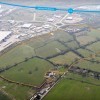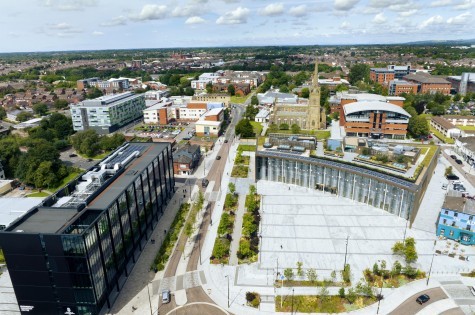When it comes to industrial applications, GRP gratings have gained significant popularity due to their exceptional strength, durability, and versatility. GRP, which stands for Glass Reinforced Plastic, is a composite material made by reinforcing plastic with fine glass fibres. This combination creates a strong and lightweight material suitable for a wide range of uses.
What is a GRP Grating?
GRP grating, short for Glass Reinforced Plastic grating, is a structural component made from a combination of plastic and fine glass fibres. These gratings consist of a network of interwoven glass fibres encased within a matrix of plastic resin. The manufacturing process involves pultrusion or moulding techniques to create sturdy panels that are lightweight, non-corrosive, and resistant to fire, chemicals, and UV rays.
Benefits of GRP Grating
GRP gratings offer a multitude of benefits, making them an ideal choice for a wide range of industrial and commercial applications. Let's explore some of their key advantages:
1. Strength and Durability
GRP gratings are exceptionally strong and durable, capable of withstanding heavy loads without compromising their structural integrity. The glass fibers provide reinforcement, resulting in high strength-to-weight ratio. This durability ensures long-lasting performance even in harsh environments.
2. Lightweight
Compared to traditional materials like steel or concrete, GRP gratings are significantly lighter. This characteristic makes them easier to handle, transport, and install, while also reducing the load-bearing requirements on supporting structures.
3. Corrosion Resistance
One of the standout features of GRP gratings is their excellent resistance to corrosion. Unlike metal gratings, which are prone to rust and corrosion, GRP gratings are impervious to moisture, chemicals, and saltwater. This resistance makes them suitable for applications in marine environments, wastewater treatment plants, and chemical processing facilities.
4. Non-Conductive
GRP gratings possess inherent electrical insulating properties, making them ideal for applications where electrical conductivity needs to be minimised. They provide a safe and reliable solution for industries such as power generation, telecommunications, and oil and gas.
5. Slip Resistance
The top surface of GRP gratings is often designed with an anti-slip texture, providing excellent traction even in wet or oily conditions. This feature enhances safety in environments where slips and falls are a concern, such as walkways, stairs, and platforms.
6. Low Maintenance
GRP gratings require minimal maintenance, resulting in cost savings over their lifespan. Unlike materials that corrode or degrade over time, GRP gratings remain stable and require only occasional cleaning to maintain their performance and appearance.
7. Design Flexibility
GRP gratings offer immense design flexibility, allowing for customisation to suit specific project requirements. They are available in various sizes, shapes, and colours, enabling architects and engineers to create aesthetically pleasing structures while meeting functional needs.
Applications of GRP Gratings
GRP gratings find extensive application in a wide range of industries and sectors. Their versatility and remarkable properties make them an excellent choice for the following:
1. Industrial Flooring
GRP gratings are widely used as flooring solutions in industrial settings, providing slip-resistant surfaces for walkways, platforms, and access ramps. Their corrosion resistance and durability make them ideal for areas exposed to chemicals, oils, and heavy machinery.
2. Marine and Offshore
In the maritime industry, GRP gratings are favoured for applications on ships, offshore platforms, and docks due to their resistance to saltwater, UV rays, and harsh weather conditions. They are utilised for walkways, deck grating, and safety barriers.
3. Chemical and Petrochemical
Given their resistance to chemicals, GRP gratings are extensively employed in chemical processing plants, refineries, and petrochemical facilities. They serve as platforms, stair treads, and access covers in areas exposed to corrosive substances.
4. Water and Wastewater Treatment
GRP gratings are commonly used in water and wastewater treatment plants, where they provide slip-resistant flooring for walkways and bridges. Their resistance to moisture and chemicals makes them a reliable choice for these demanding environments.
5. Power and Utilities
In the power generation and utility sectors, GRP gratings are utilised in electrical substations, switchyards, and power plants. Their non-conductive properties ensure a safe working environment around high-voltage equipment.
6. Construction and Architecture
GRP gratings find application in architectural and construction projects, where their design flexibility and aesthetic appeal are highly valued. They are used for sunscreens, fencing, decorative screens, and other structural elements that require both functionality and visual appeal.
GRP gratings are a remarkable structural component that offers numerous advantages in terms of strength, durability, corrosion resistance, and design flexibility. With their lightweight construction, slip resistance, and low maintenance requirements, they have become a preferred choice across various industries and applications.
Understanding what GRP gratings are and their multitude of benefits allows engineers, architects, and industry professionals to make informed decisions when selecting materials for their projects. As technology continues to advance, GRP gratings will likely witness further innovation and find their way into even more applications, solidifying their position as a versatile and reliable solution.


















